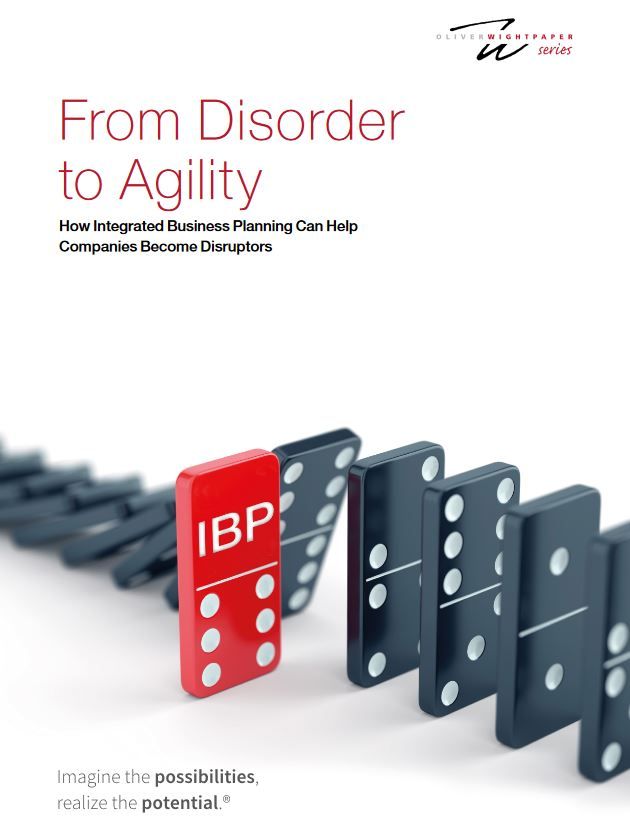A recent Oliver Wright whitepaper ‘From Disorder to Agility’ discusses how Integrated Business Planning can help businesses become disruptors. It provides an insight into how by following a structured, integrated business planning process across the organisation, operations can put in place robust processes, supported by embedded technologies, that let them anticipate and mitigate damaging impacts of disruptive events. IBP also empowers teams with the insights required to make rapid, informed decisions that helps the business proactively create new opportunities and become a successful market disruptor.
IBP supports a wide range of capabilities that enable operations to become more efficient at detecting and proactively adjusting to changing markets.
IBP supports a wide range of capabilities that enable operations to become more efficient at detecting and proactively adjusting to changing markets.

Looking further into the future with confidence, spending time on analysis instead of data collection and making data-driven decisions on the latest information are some of the rewards of having an IBP approach across an operation.
Look further into the future
Scenario modelling lets planners explore the options in the case of potential disruptions, such as a delay in the delivery of a raw material or what would happen if taxes change in a particular market. By running a wide range of scenarios across the operation the impacts on ability to meet demand and the load on the supply chain as well as any financial consequences can be anticipated. Then, by identifying specific vulnerabilities or emerging opportunities appropriate decisions to prepare can be taken.
Extending the planning horizon beyond the next year is also critical if businesses are to track and respond proactively to changing markets. A planning horizon of at least 36 months enables companies to constantly align themselves to developing market requirements and detect new trends that may affect specific product development requirements or peaks in demand.
Extending the planning horizon beyond the next year is also critical if businesses are to track and respond proactively to changing markets. A planning horizon of at least 36 months enables companies to constantly align themselves to developing market requirements and detect new trends that may affect specific product development requirements or peaks in demand.
Spend time on analysis, not data collection
Unified data management eliminates the need to manually compile reports from multiple sources. Robust processes supported by advanced technological capabilities release employees to run scenarios and carry out analysis rather than collecting and collating data. Intelligent AI and machine learning analytics help ensure easy access to meaningful insights, meaning that planning executives can focus on business-critical decision-making.
Make data-driven decisions based on the latest information
Too often, strategy is determined on gut feel rather than in-depth analysis of the market. Where decision-making is based on data, yearly budgeting practices can mean that information is out of date.
By shifting to a rolling financial forecast, companies can help ensure that decisions are made based on the very latest data-driven predictions. In this way, planners are not simply making decisions based on historical data but are instead navigating their way forward using the very latest insights into market trends and opportunities. Constant re-evaluation of market conditions enables businesses to pivot quickly and change direction if things change.
By shifting to a rolling financial forecast, companies can help ensure that decisions are made based on the very latest data-driven predictions. In this way, planners are not simply making decisions based on historical data but are instead navigating their way forward using the very latest insights into market trends and opportunities. Constant re-evaluation of market conditions enables businesses to pivot quickly and change direction if things change.


Establishing Integrated Business Planning in the Organisation
The key elements required to establishing Integrated Business Planning in an operation to gain the agility to process data quickly and make smart and informed decisions are reliable processes across the business helping employees to work move efficiently and collaboratively, comprehensive integrated processes to guide the right behaviour so your workforce is working as efficiently as possible. A final key element is capable technology to support digitalised and automated processes which improves efficiency and can establish a single source of truth enabling business wide reports in real time.

Reliable processes
Centralised, standardised, and integrated processes across all business units and functions enable streamlined workflows and help employees work more efficiently and collaboratively. Meanwhile, having a unified, process-driven approach helps improve visibility across operations, so planners can quickly access the information needed to support data-driven decision-making.
The right behaviour
Comprehensive, integrated processes guide employees’ behaviour so they are working as efficiently as possible – in compliance with key requirements for each task – while enabling tracking, monitoring, and reporting on core KPIs. However, if processes are disjointed and unreliable, people invent their own ways of working with silo focused KPIs and success definitions. This behaviour results in a proliferation of spreadsheet-based management systems, creating data silos that can make reporting a challenge.
Capable technology
Advanced enterprise software, such as the SAP Integrated Business Planning for Supply Chain (SAP IBP) solution, supports digitalised and automated processes that enable employees to carry out day-to-day tasks efficiently. Furthermore, by establishing a single source of truth across the organisation, companies can run enterprise-wide reports in real time.
Summary
Using IBP as the way to run a business can help deliver insights that enable smaller companies to outstrip larger, less-agile rivals. Sophisticated IBP technology was once only available for larger enterprises but cloud solutions such as SAP IBP are now accessible to companies of every size and can be integrated with SAP or other ERP vendors. So, IBP is a means to providing game-changing insights to help organisations detect and act on new opportunities.
Contact us to find out more
Speak to us about how our team can assist you.




